Is MLB’s Non-Waiver Trade Deadline Too Early?

When people ask me what my favorite sports are, I usually answer “Basketball, baseball, world football, and American football” in no particular order. When it comes to American football, I don’t watch much of the NFL pro league, but I really enjoy the college game. To that list, I should add one other sport also, which is “the business of baseball.”
When it comes to the business of sports, there’s nothing so entertaining to me as Major League Baseball in North America with its huge quantity of trades, free agent signings, and roster management decisions. Following the endless machinations of the teams’ front offices is like an entire off-field league.
Sure, fans in other sports can get excited about their favorite team signing or drafting an important player. The NBA, particularly, is getting very exciting in the offseason as basketball stars change teams. But even in basketball, it’s still a handful of interesting names moving around. There is no sport quite like baseball for the sheer number of additions, subtractions, and opportunities to tweak each team’s roster.
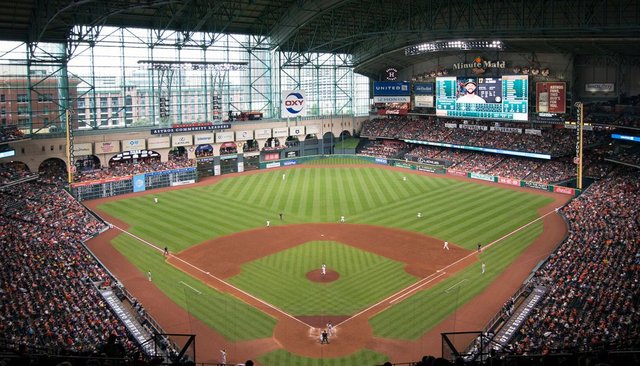
Minute Maid Park, home of the Houston Astros. ballparksofbaseball.com.
The business of baseball
Transactions occur year-round, but there are some key points to watch on the calendar for fans of ‘the business of baseball’. One is the winter offseason, when many contracts expire, setting off “Hot Stove” frenzy among hardcore fans. They watch as their favorite teams vie to sign or trade for the best talent and complementary pieces, keeping roster costs within their budgets. In the past, most major free agent signings and trades were completed before Christmas, but more recently teams have been signing players later, right up until their spring training camps start in February.
The second most interesting time of the year for the “business of baseball” fans comes at the end of July. This is called the non-waiver trade deadline and it arrives just past the midpoint in the MLB season. Since the season begins in late March/early April, teams have been playing for nearly four months straight by July 31. By then, the teams should know how good their players are and how good the team’s chances look for finishing well and making it into the post-season playoffs.
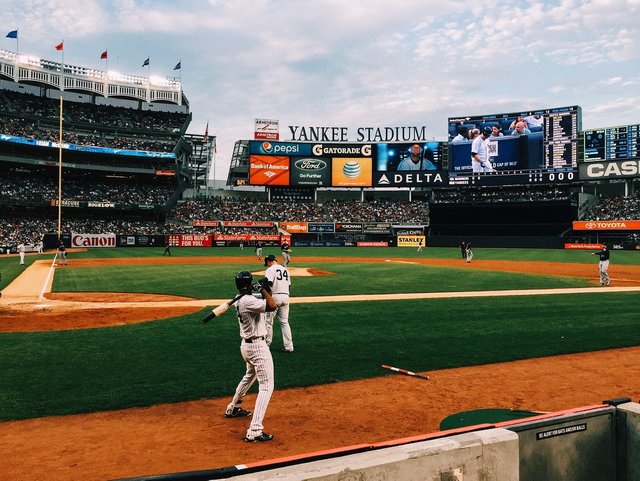
Yankee Stadium, home of the New York Yankees. Public Domain.
After July 31, it is possible to add players via trades with other teams, but only if those players pass through waivers, a process under which other teams sometimes can claim them and foil the trade. So any non-waiver trades must be completed by the end of July. And that makes July 31 a special date on the calendar because fans are almost guaranteed to see some players change teams in the days and weeks leading up to it. July 31 blockbuster “deadline day deals” also occur in most years.
Teams that are doing well become “buyers” at the July 31 trade deadline, often negotiating to add useful players from other teams that meet particular needs (e.g., a second-baseman or a left-handed relief pitcher). Teams that are underperforming may become “sellers”, trading away good players to contending teams. In return, the underperformers are able to dump salary and/or to add younger prospects to help re-stock their systems affordably for future years.
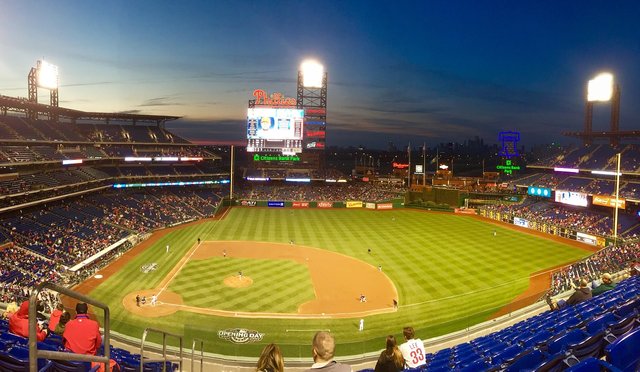
Citizens Bank Park, home of the Philadelphia Phillies. Public Domain.
The classic rebuild
The classic “seller” technique is a full-scale rebuild. If you look at the Houston Astros, for example, the team’s ownership and fan base put up with tough times. For several years, Houston was in the cellar in the standings. It kept a small payroll, had few notable players, and traded away assets for prospects and affordable long term pieces. Its poor finishes also put the Astros in prime position for amateur player drafts, where Houston had some top picks and selected some of the top young players in the nation to add to their system.
Fast forward: In 2017, the Houston Astros won a championship. And they did so with a very talented young team. In other words, the team has financial control over most of these players for the next several years. Houston may win more than one championship over the next few years, and certainly will compete for them every year. How did the team assemble such a talented, affordable group of players? By tanking, accepting last place finishes and poor play as it reloaded for this future, multi-year run for the glory. The Philadelphia Phillies and Atlanta Braves put up with some lean years, drafted and traded well, and also are emerging from rebuilds with some very young, talented teams.

Guaranteed Rate Field, formerly known as U.S. Cellular Field, home of the Chicago White Sox. Public Domain.
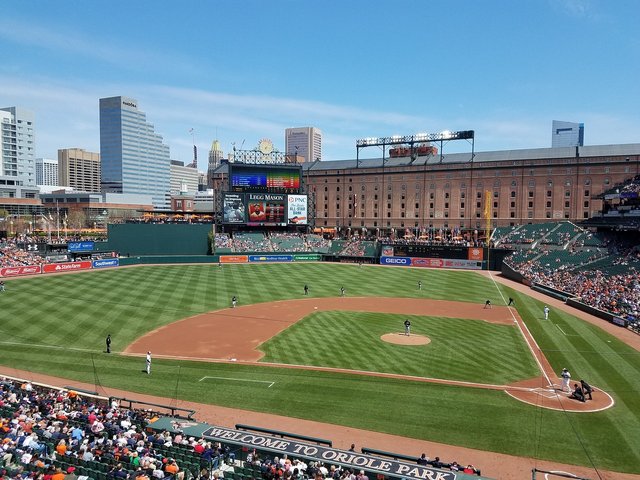
Some teams have trouble entering that full-scale rebuild. Three examples are the Chicago White Sox, Baltimore Orioles, and Texas Rangers. The Orioles have been flailing around for years, often average in quality but never really challenging the division’s top teams, the New York Yankees and Boston Red Sox. The bigger market teams consistently outspend and outperform the O’s. The Orioles have suffered under some of MLB’s worst ownership in Peter Angelos, who has been willing to spend money on occasional splashy free agents, but who consistently vetoed and blocked trades that would have made the team much better over a multi-year period, though they finally were smart enough to trade off a few assets this year for prospects. The White Sox and Rangers, also, have been hesitant in the past to leverage the team’s best talent into future prospects and building pieces.
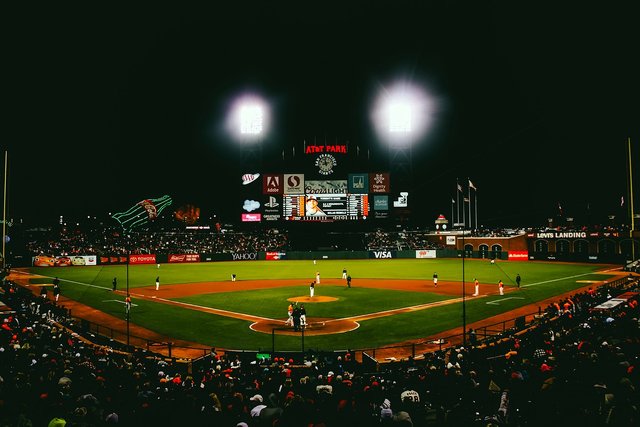
AT&T Park, home of the San Francisco Giants. Public Domain.
What about two teams that could have done more, but essentially stood pat?
The Washington Nationals and San Francisco Giants both faced “Come to Jesus” moments this July 31. Their stories could not be more different over the last 10 years or so. Washington has entered more than one of those seasons (and even the post-season playoffs) as favorites to win a championship with an extremely deep and talented roster. Yet not only do the Nats not have any World Championship trophies; they’ve even had trouble getting very far in the playoffs. In past years, we’ve seen player fights in the dugout towards the end of their season. There have been rumors of discord in the management ranks. And the front office has hired multiple managers, but reportedly not given any of them the benefit of the doubt as far as trust.
For the San Francisco Giants, the trophy case looks better: the team has won three titles in the last decade. Thanks to good pitching, defense, smart management, and timely hitting, the team has bumbled its way into the playoffs several times and beaten teams (including Washington) that were probably more talented on paper. But that reign came to an end just as the newest live ball era launched with teams beginning to hit many more home runs. The Giants’ roster was not built for that, its pitchers are aging, its minor league system is low on replacement talent, and it now faces several years of bad contracts for older players who can no longer contribute the way they once did.
July 31 works as a trade deadline because the numbers show that a team which is underwater at that point has little-to-no chance of making the playoffs. If there is little such chance, then why pay for salaries that can be shed? Why not trade players who are in demand in order to re-stock for future years? Nothing to lose, right?
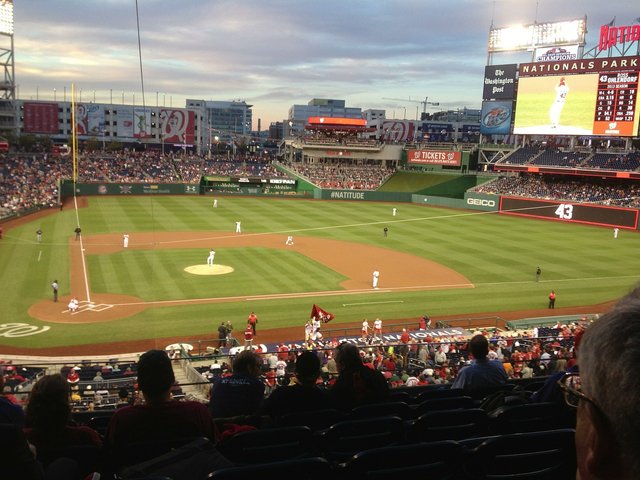
Nationals Park, home of the Washington Nationals. Public Domain.
In early July, it was clear that both the Nationals and Giants would need to play better if they would have any chance of being trade deadline “buyers”. Other marginal teams rose to this occasion, such as the Pittsburgh Pirates and Oakland Athletics, both of which went on torrid winning streaks to dominate those key two-week stretches of baseball to the point where both have a healthy chance of making it to the postseason.
If they would not be buyers, should they be sellers? Both the Nationals and Giants ended up around a middling .500 record when July 31 came this year. By most accounts, they would need to be several games better in the standings to have any real chance. But at .500, there is still a small chance. There are several modern instances of teams being 5-8 games back in July and going on runs to win their divisions.
Teams that aren’t ready to sell
Unless Washington retains its top star, Bryce Harper (who is a free agent after his contract expires at the end of this season), then this year may be the end of its window with the current roster. Based on what I’ve read about Washington’s mismanagement, I think he’d be crazy to sign again there, but he’ll probably go to whichever team offers him the most. Point is: Washington’s front office will probably have a lesser team next year. They almost have to go for it this year, don’t they? Or they could throw in the towel and build for a future which probably won’t include the front office regime, which might be kicked out before such a rebuild bears fruit.
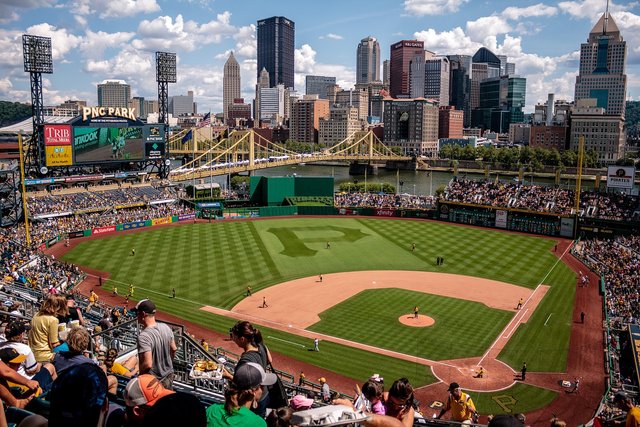
PNC Park, home of the Pittsburgh Pirates. Public Domain.
With San Francisco, the Giants are a team that fills the stadium for almost every game. It’s near downtown and going to a baseball game right on the water of San Francisco Bay is a fun, pleasant experience for many people. It’s fair to say that S.F. may not need a high performing team to make money on tickets and concessions. But would a bad team still draw fans?
The Giants may be one team that can afford to stay around the middle of the pack, let expiring contracts expire, and hopefully add just enough pieces that they can remain competitive most years. The team has some really bad contracts, though, and without going over the luxury tax threshold next year to bring in some younger talent, it will be hard for the current team to maintain respectability for the next couple of years. To make matters worse, the team’s minor league system is devoid of high level talent because this team has not drafted well under the current regime. So any real help must come from the outside.
So perhaps both Washington and San Francisco have little alternative but to put on a brave face and pretend the teams have a chance. If they go on winning streaks within the next month, they still can add players for a postseason run if they clear waivers.
I still would argue that both of these teams missed a prime opportunity to trade talented, in demand players or expiring contracts that could have helped other teams at this juncture. Brandon Belt or Will Smith should be in great demand from the Giants, just as Kelvin Herrera and Ryan Madson should be from the Nats (to use just two examples per team). Think of the talented prospects that either GM could have leveraged out of those deals. And yet, they stood pat at the deadline, even in hte face of a seller's market for relief pitchers.
Compare their lack of return to the deal that the Yankees got two years ago when they traded relief pitcher Andrew Miller to the Cleveland Indians. That trade netted them Clint Frazier and Justus Sheffield, two of the games most talented and elite prospects.

Screenshot from https://www.si.com/mlb/2016/07/31/yankees-indians-andrew-miller-trade-clint-frazier
I think both the Nationals and Giants are in denial and that they made mistakes in not taking the opportunity to improve themselves for the future. It doesn’t need to be a full teardown; some other teams have gotten really good at adding key players who can contribute within a year or two, meaning that they do not have to suffer through a 5-year rebuild.
And yet, I can respect that the deadline may have come just a few weeks too early for each team to throw in the towel on its chances for this year.
Does that mean the trade deadline is too early? What if it were moved forward by 3-4 weeks, well into August? That would create some better certainty as far as each team’s chances of making the postseason playoffs. And it would more clearly label which teams are buyers and sellers. That would make the speculation less fun, but it might do a better job of serving the interests of baseball.
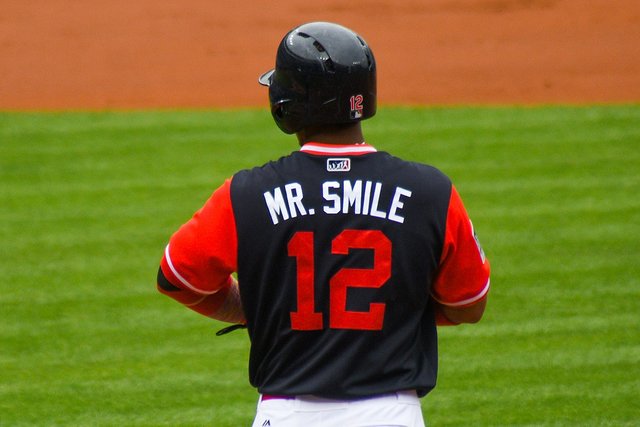
Francisco Lindor of the Cleveland Indians wears "Mr. Smile" on the nickname jersey day. Creative Commons via Wikimedia.com by Eric Drost. Other images public domain unless otherwise indicated.
I still prefer football to all sports, maybe because I'd like to be a footballer tomorrow, our different choice differentiate our choices
Baseball is a good game too but after football. Hehehe
It's a great game also!
As a huge sports fan, I have always been a big watcher of trade deadlines. I love seeing team jockey for position and the big name players move to new teams and try to fit in. To be perfectly honest, I have never been a fan of baseball teams being able to make trades after the deadline. I get that the players need to pass through waivers but I think that once the trade deadline has passed then the teams should stick with what they have. I would suggest moving the deadline a week or two later and get rid of the trades after the deadline. Like you said, teams have been playing for months now and know what they have.
Exactly. Then they wouldn't need that second deadline in August. And teams would know exactly what they need.
The stadium will look very nice to see, where it is located?
Those stadiums are in the U.S.
This stadium is really nice to see!
The stadium will
Look very nice to see, where
It is located?
- sagor5828
I'm a bot. I detect haiku.
Very comprehensive article. This would be the argument for an strategy video game or a table game. It reminded me of the movie "Moneyball".
Similarly interesting is the business strategies behind F1.
That’s true, especially when James is changing the teams.
I’m actualy really surprised especially when it comes to Giants. I had pretty high view about this team. All I can say is that teams such as NY Yankees are actualy investing in their youth. That’s the potential future. I’m not sure if there is any other team who raised their own players so consistently. Even though Yenkees are not at their top recently, they have the most successful team of All and I believe they eventually will again. With that said, solely based on a young talent and spending ability the best teams with brightest future are in my opinion Yankees, Astros, Braves and Phillies. But that’s my opinion.
Anyway great article about team’s drafts and their deadlines.
Yes, those are the best teams right now and for the next few years. The Dodgers and Red Sox might belong there also for now, but I'm not sure their minor league systems are as deep as the ones you mentioned. The Giants could be better on paper, but they rely on a lot of older players and when that happens, some injuries are inevitable. Unless every player on that roster overperforms over the next few months, they won't be in the playoffs.
The transactions between team players in baseball are very interesting. Starting because unlike other sports, as players can easily reach 40 years of age playing, and that does not influence much team chemistry as in football (say) because each player plays in a position and individually. The most important thing is that you can find talent everywhere in MLB, that league is full of talented players that can be acquired, as well as the young promises that can climb from the AA and AAA respectively.
Another alternative is to be able to find players in the list of free agents, once the contract with their previous teams has ended and they can compete in the negotiations.
That's true. The game is a sum of individual performances; there are fewer opportunities for teamwork than in many other sports. And yes, there are many sources of talent, some young and some old!
Love Bartolo Colon....still pitching at age 45 which is very rare.
I'm not very fond of baseball, but my husband is, it's true what you say in your publication, besides a sport is a whole business, shopping, sales, changes.... you see that you are a big fan, you know a lot about baseball, and I learned something else today
Thanks for the comment!
I'd love to add something of worth here @donkeypong, but sadly, this is way out of my league (pun intended :)
If Brian is up to it, I'll ask him to pop over because he loves this kind of stuff and tries to talk to me about it, but stops when he sees my eyes glaze over haha
Send him over! I hope both of you are doing well.
I'll do that! We are hanging in there as well as we can. Some good days, some bad ones, but we try to enjoy every day regardless. What else can we do? :)
It's interesting how two different perceptions of the same event will change one's opinion. I don't like baseball's free agency because it involves so many moving parts, which is exactly why it seems to intrigue you. I definitely prefer the NBA and NFL's trade markets as they are much easier to follow.
I grew up pretty heavily invested in baseball playing it in high school and working to earn a scholarship in college. When that dream didn't materialize I pretty much stopped paying attention to the game. I can't remember the last time I watched an entire baseball game on TV.
It's a lot to sit through unless good teams are playing, but a lovable game nonetheless.
Hello friend how are you, the business of sports is something that very few people dominate, but I can tell you that when they sign a Venezuelan is a great joy
You are a fan and I notice it because of the so emphatic and interesting way that you write that even me that is not baseball is captivated with this post
I am Venezuelan and it is a great pride that a person like you speaks about baseball that is very important for us since we have very good teams in venezuela if you ask me my favorite are
The tigers of aragua
The Venezuelan players are great!
Thanks, it's a pride!